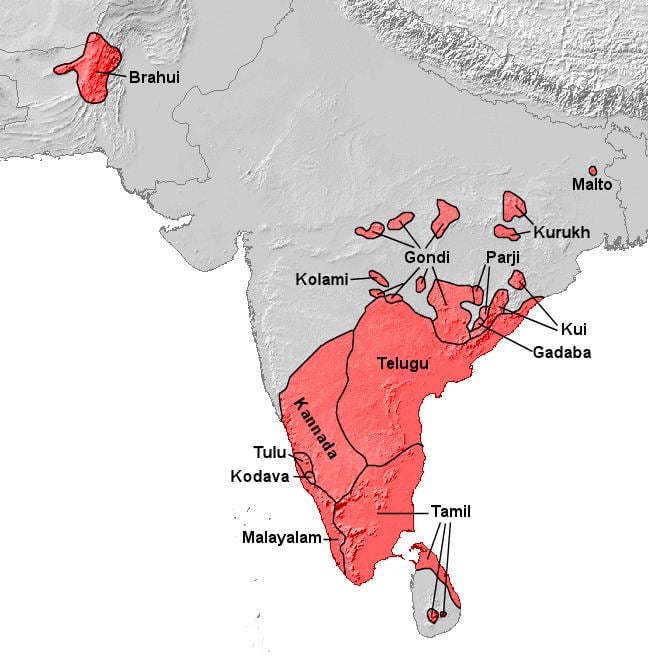Ethnicity Brahui | Native speakers 4 million (2011) | |
 | ||
Regulated by Brahui Language Board (Pakistan) | ||
Brahui /brəˈhuːi/ (Brahui: براہوئی) is a Dravidian language spoken by the Brahui people in the central Balochistan region of Pakistan and Afghanistan, and by expatriate Brahui communities in Qatar, United Arab Emirates, Iraq, and Iran. It is isolated from the nearest Dravidian-speaking neighbour population of South India by a distance of more than 1,500 kilometres (930 mi). Kalat, Mastung Khuzdar and parts of Quetta districts of Balochistan are predominantly Brahui-speaking.
Contents
Distribution
Brahui is spoken in the central part of Pakistani Balochistan, mainly in Kalat, Mastung, and Khuzdar districts but also in smaller numbers in neighboring districts, as well as in Afghanistan which borders Pakistani Balochistan; however, many members of the ethnic group no longer speak Brahui. The 2013 edition of Ethnologue reports that there are some 4 million speakers. Nearly all live in Pakistan, mainly in the province of Balochistan. There are also an unknown very small number of expatriate Brahuis in the Arab States of the Persian Gulf, Iranian Balochistan, and Turkmenistan.
Classification
Brahui belongs, with Kurukh (Oraon) and Malto, to the northern subfamily of the Dravidian family of languages. It has been influenced by the Iranian languages spoken in the area, especially Balochi.
Dialects
There are no important dialectical differences. Jhalawani (southern, centered on Khuzdar) and Sarawani (northern, centered on Kalat) dialects are distinguished by the pronunciation of *h, which is only retained in the north. (Elfenbein 1997)
Phonology
The vowels are the same as Balochi: long a e i o u, short a i u, diphthongs aj, aw. Stress has also been borrowed from Balochi, and occurs on the first long vowel or diphthong, or on the first syllable if all vowels are short.
Consonants are also very similar to those of Balochi, but Brahui has more fricatives and nasals (Elfenbein 1993).
Orthography
Brahui is the only Dravidian language which has not been written in a Brahmi-based script; instead, it is written in the Arabic script since the second half of the 20th century. More recently, a Roman-based orthography named Brolikva (an abbreviation of Brahui Roman Likvar) was developed by the Brahui Language Board of the University of Balochistan in Quetta, and adopted by the newspaper Talár.
Below is the new promoted Bráhuí Báşágal Brolikva orthography:
The letters with diacritics are the long vowels, post-alveolar and retroflex consonants, the voiced velar fricative and the voiceless lateral fricative.
Endangerment
According to a 2009 UNESCO report, Brahui is one of the 27 languages of Pakistan that are facing the danger of extinction. They classify it in "unsafe" status, the least endangered level out of the five levels of concern (Unsafe, Definitely Endangered, Severely Endangered, Critically Endangered, and Extinct).
Publications
Talár is the first daily newspaper in the Brahui language. It uses the new Roman orthography, and is "an attempt to standardize and develop [the] Brahui language to meet the requirements of modern political, social and scientific discourse."
History
There is no consensus as to whether Brahui is a relatively recent language introduced into Balochistan or remnant of an older widespread Dravidian language family. According to Josef Elfenbein (1989), the most common theory is that the Brahui were part of a Dravidian invasion of north-western India in 3rd millennium BC, but unlike other Dravidians who migrated to the south, they remained in Sarawan and Jahlawan since before 2000 BC. However, some other scholars see it as a recent migrant language to its present region. They postulate, that Brahui could only have migrated to Balochistan from central India after 1000 CE. The absence of any older Iranian (Avestan) loanwords in Brahui supports this hypothesis. The main Iranian contributor to Brahui vocabulary, Balochi, is a Northwestern Iranian language, and moved to the area from the west only around 1000 CE. One scholar places the migration аs late as the 13th or 14th century.
